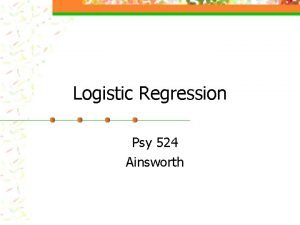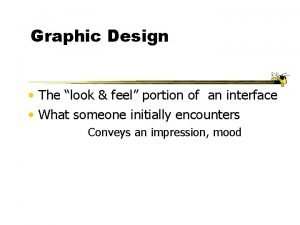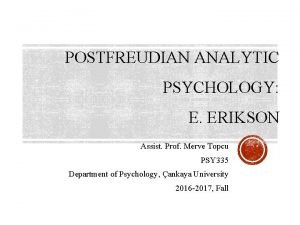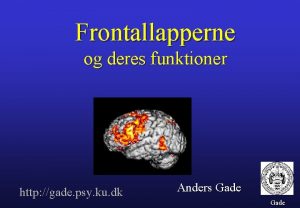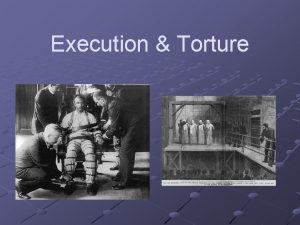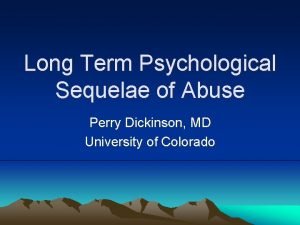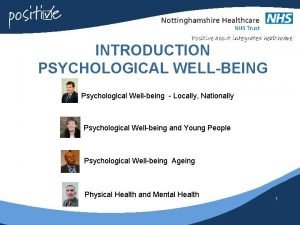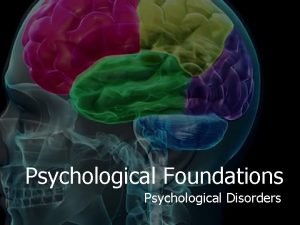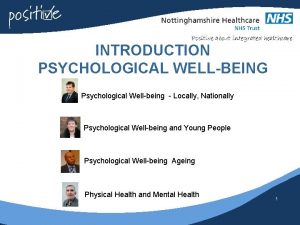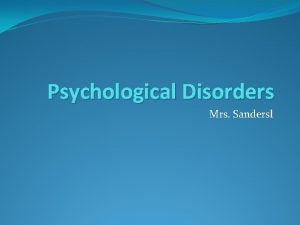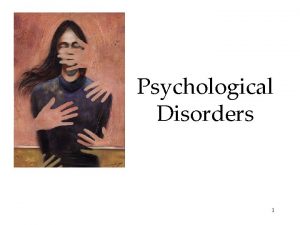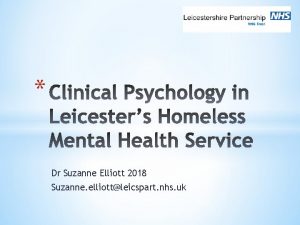Psychological Sequelae of Torture Suzanne R Merlis Psy
























- Slides: 24

Psychological Sequelae of Torture Suzanne R. Merlis, Psy. D.

Torture: n Is the deliberate intention to destroy the physical and/or psychological well-being of an individual. n Impacts the will and dignity of the individual, communities, associations, and movements. n Is documented in 151 countries.

Definitions cont: n A sociopolitical act: “ a strategy used to undermine political leadership and intimidate entire communities so that they will submit to the will of those in power or those seeking power. ” § Andrea Northwood, Ph. D. Center for Victims of Torture, Minneapolis, Minnesota

Definition’s Cont: n A personal definition: “ When individuals become the target of political violence, their worlds crumble. There is nothing life giving left. Trust in one’s self, in humanity, and in God is shattered. The survivor feels more kin to the dead than the living. We are left with fear, guilt, humiliation, helplessness, shame, nightmares, flashbacks, hideous memories. The survivors world, a world we wish to flee. ” Sister Diana Ortiz (1998)

The Triple Trauma Paradigm n The trauma event n Flight n Resettlement and acculturation

Series of Impacts and Injuries n Multiple Losses : Control, identity, voice, trust, beliefs, meaning, values, relationships n Physical and psychological symptoms (Acute & Chronic Illness, PTSD) n Symptoms can be understood as a “normal” response to profoundly abnormal and aversive circumstances n Duration of symptoms and exacerbation of new stressors =more psychological harm

The Trauma Event Contextual Framework- how did the event come about? n Culture n Sociopolitical background and heritage n Theory and Practice of Torture n Acts of Torture (Physical , Sexual, and Psychological)

Flight n Attempts to escape- how many? n Escape and Exile- how did they get out? n Route of Transit- how did they get here? n Arrival- what happens when they get here?

Resettlement Trauma of Displacement n Immigration status/asylum process n Adjustment (loss of ties to one’s land identity) n Basic needs unmet n Separation from family and cultural supports n Continued persecution of family and friends n Lack of safety and security

Key Aspects of PTSD Interaction between two factors: n painful and intrusive memories of the trauma n the defenses used to ward off those memories

Trauma Symptom Categories

Re-experiencing the Trauma n Flashbacks n Intrusive thoughts and memories n Nightmares with content of the trauma n Triggers

Avoidance n Avoidance of thoughts, conversations, activities, places, or people n Emotional constriction n Social withdrawal n Personal detachment n Inability to recall details of the trauma

Hyperarousal n Difficulty falling asleep and staying asleep n Irritability or increased anger n Difficulty concentrating n Hypervigilance n Startle response n Generalized anxiety n Gastrointestinal distress

Depression n n n n Loss of pleasure Appetite disturbance Sleep disturbance Psychomotor agitation or retardation Chronic fatigue Feelings of worthlessness Diminished attention, concentration, and memory Thoughts of death and dying, suicidal ideation

Altered Self-Concept n Personality change n Feeling of being damaged, contaminated n A sense of fore-shortened future n Problems of impulse control resulting in atypical behavior

Dissociative Symptoms n Dissociation n Depersonalization

Sexual Dysfunction n Fear of sexual activity n Fear of homosexuality n Erectile dysfunction n Disturbance in sexual arousal

Psychotic-like Symptoms n Delusions n Hallucinations n Bizarre ideation and behavior n Perceptual distortions n Paranoia

Common Somatic Complaints n Headaches n Back pain n Musculoskeletal pain

Beyond PTSD n Complex PTSD (Herman, 1997) n Alterations in affect regulation n Alterations in self-perception n Alterations in relations with others n Alterations in consciousness

Recovery n Guiding principle: Restoring power and control n Process can be slow n Outcomes of traumatic experience is a consequence of multiple factors n Access to culturally appropriate therapeutic, rehabilitative, social and legal services

Navigation of the Asylum Process Retraumatizing Events n Story is not believed (have to prove and document) n Interface with systems- legal, health, governmental, social n Physical surroundings n Telling often means re-living

Asylum process cont: Retraumatizing Effects n Loss of control n Guilt (self-blame or survivors guilt) n Memory lapses and credibility problems n Degradation and depersonalization n Increased isolation and vulnerability n Time is often frozen






